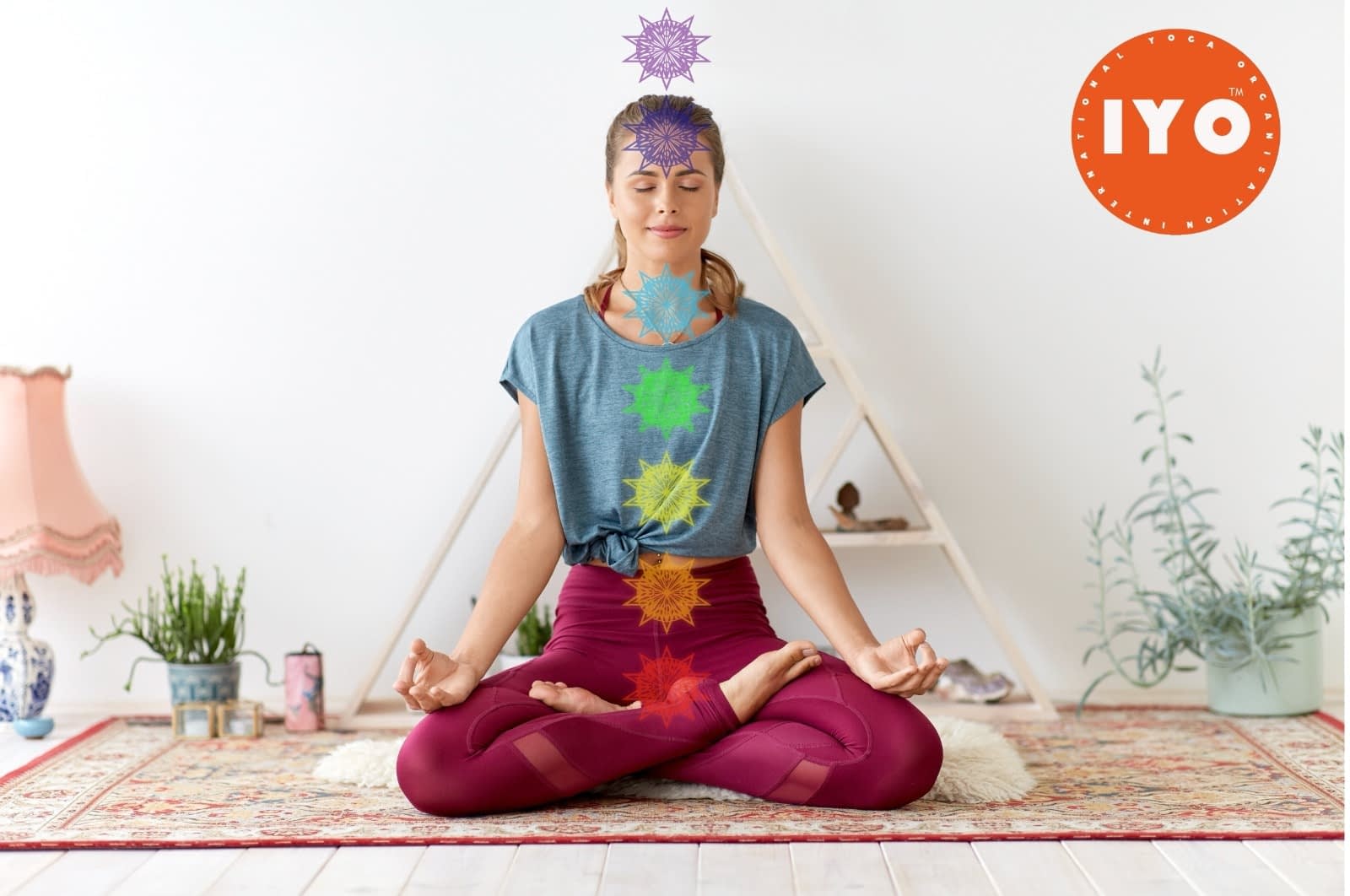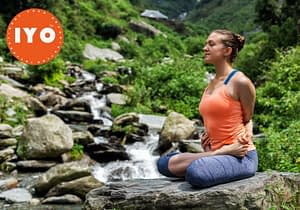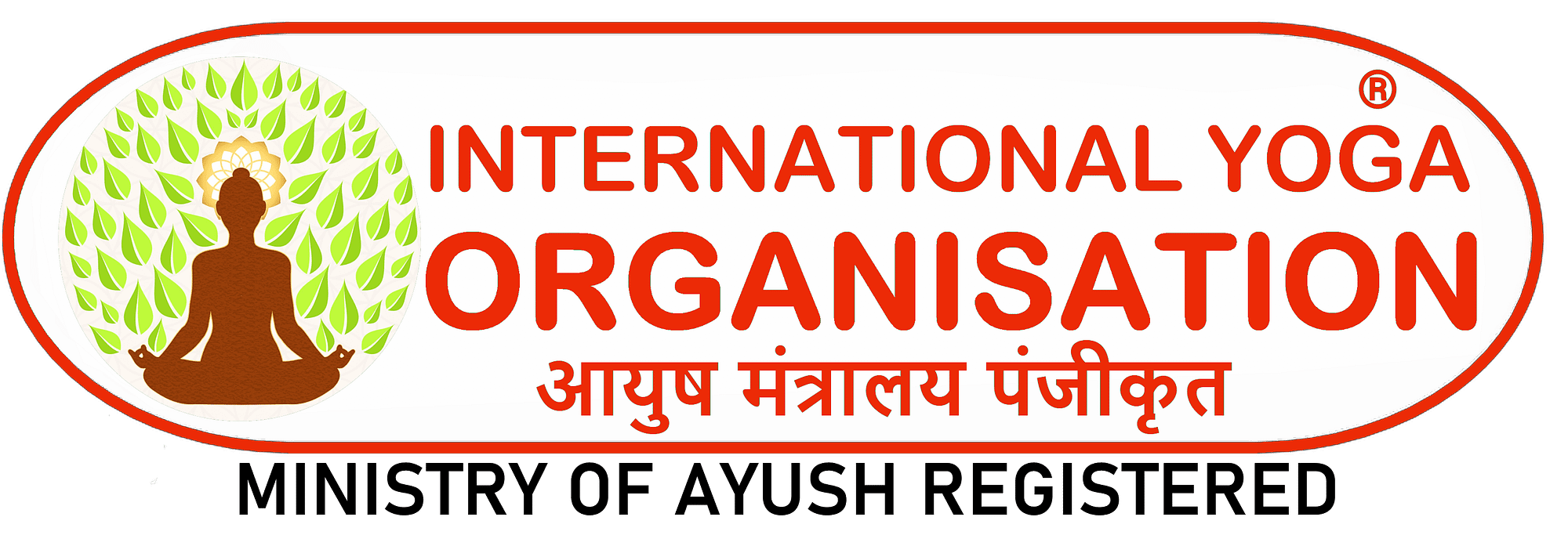
The IYO® Special poses for meditation: easy and kneeling
 It’s time to take a load off! Lots of great and challenging IYO yoga postures, as well as the meditative postures, are accomplished while sitting. Sitting poses keep your hips and legs flexible. You may even want to adapt some of the following poses for when you happen to be sitting on the floor outside of your regular IYO yoga practice—just one more way to fit IYO yoga into your day!
It’s time to take a load off! Lots of great and challenging IYO yoga postures, as well as the meditative postures, are accomplished while sitting. Sitting poses keep your hips and legs flexible. You may even want to adapt some of the following poses for when you happen to be sitting on the floor outside of your regular IYO yoga practice—just one more way to fit IYO yoga into your day!
Dandasana: Staff Pose
A staff is a big stick used for support, like a walking stick. It is also a symbol of authority—he or she who holds the staff has the appearance of being large and incharge! Staff pose helps us to internalize this feeling of confidence, increasing our concentration and clarity of focus. Dandasana (pronounced dahn-DAH-sah-nah) is also great for your alignment. Concentrate on your upper body becoming straight and powerful as a staff.
If the staff pose is uncomfortable, sit on a folded blanket until you become more flexible. Don’t puff out your chest. Imagine, instead, that your head is being pulled upward, which will also keep your back from sinking down and your chin from coming up. Your chin should be in line with the floor.
Baddha Konasana: Butterfly Pose
Literally translated as “bound angle pose,” this pose imitates a butterfly resting its
wings on a lotus blossom. When holding baddha konasana (pronounced BAH-dah
koh-NAH-sah-nah), imagine the delicate beauty of this image of the butterfly. The butterfly pose opens your hips and Jupiter chakra (the chakra located in your pelvic area). It also loosens your knees and ankles.
Virasana: Be a Hero!
A hero stands tall and proud, even when sitting on the floor! The hero pose refreshes your legs, stretches your knees, and balances your Saturn chakra (located at the base of your spine). Virasana is pronounced vir-AH-sah-nah. The hero pose also teaches you to expand your breathing space even while sitting. Imagine lifting from the top of your head and anchoring your hips to the floor. Letyour breath expand everything in between.
The hero pose can be hard on delicate knees if performed too quickly or attempted before your flexibility allows it. Go very gradually into this pose so you can feel at what point your knees are telling you to stop. If this is hard to do, sit on a telephone book. Every time you practice, tear out one page. In other words, go slow. You’ll get a little farther each time.
Gomukhasana: Holy Cow!
Appropriately, the cow pose is meant to lead to a feeling of openness and giving. It also stimulates the nerves at the base of your spine, aids in longevity as it keeps your lower vertebrae from calcifying, opens your shoulders and chest, and activates your Saturn and Jupiter chakras (located at the base of your spine and in your pelvic area, respectively), helping to raise kundalini energy. Gomukhasana (pronounced goh-moo-KHA-sah-nah) is composed of go, which means “cow,” mukha, which means “mouth” or “face,” and of course, asana, which means “posture.”
Meditative Poses
Technically, you can meditate just about anywhere and in any position, but ideally, you should try to meditate in one of several meditative poses. Why? There’s nothing magical about the meditative poses, except that they arrange your body in a way ideal for meditation. Your spine is aligned so energy can flow freely. Your body is relaxed and comfortable. Meditative poses should feel so wonderful that you barely notice your body. If a meditative pose is uncomfortable or painful, you aren’t quite ready for it yet. Try a different one.
Mudras are special hand positions you can use while meditating to channel energy back through the body.
Sukhasana: Easy Pose
Sukhasana (pronounced soo-KAH-sah-nah) is a great meditation pose for beginners. Sukha means “joy,” and this pose should feel so good that it fills you with joy! Sukhasana facilitates pranayama, quiets the mind, and stills the body.
Vajrasana: Kneeling Pose
Vajrasana (pronounced vahj-RAH-sah-nah) is also called the Zen pose, as this is the meditation pose used by Zen Buddhist monks. Vajra means “thunderbolt” or “diamond.” Vajrasana aids circulation to the feet, lifts the spinal column, and relieves pressure on the diaphragm.
Padmasana: Lotus Pose
At last, the venerable lotus pose! You’ve heard about it, maybe you’ve seen it, perhaps you’ve even tried it. Padmasana (pronounced pahd-MAH-sah-nah) represents a lotus flower open to the light (padma means “lotus”). It keeps the spine from sagging and keeps you comfortable in meditation for longer periods of time than other positions. It also keeps your body from toppling over if you fall asleep during meditation (many wise souls have!). The lotus position keeps your chest open, gives your diaphragm lots of room, and opens your Venus chakra (located behind your heart). The lotus flower is considered sacred because it is beautiful, symmetrical, and has a long root that reaches down into the depths of a pond. The lotus flower has its roots in the muddy earth, but it works its way through the mud and eventually blooms into a perfect white flower facing the heavens! It’s easy to be so concerned with trying to achieve the lotus pose that you forget the point of being in the pose: to be comfortable in your body. Because yoga is such an internal process, even if you’re sitting in a perfect lotus pose in what appears to be quiet meditation, inside you may not be practicing yoga at all. You may be distracted, worried, or suffering. You might be stuck in the mud! True meditation is joyful.
Baddha Padmasana: Bound Lotus Pose
The bound lotus is the same as the lotus, except that your right arm goes behind your back and holds your right foot, while your left arm goes behind your back and holds your left foot. This pose is even more stable and symmetrical than the lotus pose. Whichever arm crosses on top, go the opposite way next time. Baddha padmasana (pronounced BAH-dah pahd-MAH-sah-nah) deepens all the benefits of the lotus pose, and you’ll be able to breathe more deeply. This is considered a more advanced pose than the advanced lotus pose.
➤ Sitting postures strengthen and increase flexibility in your hips and legs.
➤ Mudras are hand positions that enhance meditation by rechanneling energy
that emanates from the fingers back into the body where it can stimulate the chakras.
➤ Meditate only in a posture that is perfectly comfortable. Some suggestions:
easy, kneeling, and lotus.
➤ A straight spine makes a meditation pose meditative.
➤ If you’re down, move around. Feeling great? Meditate!


